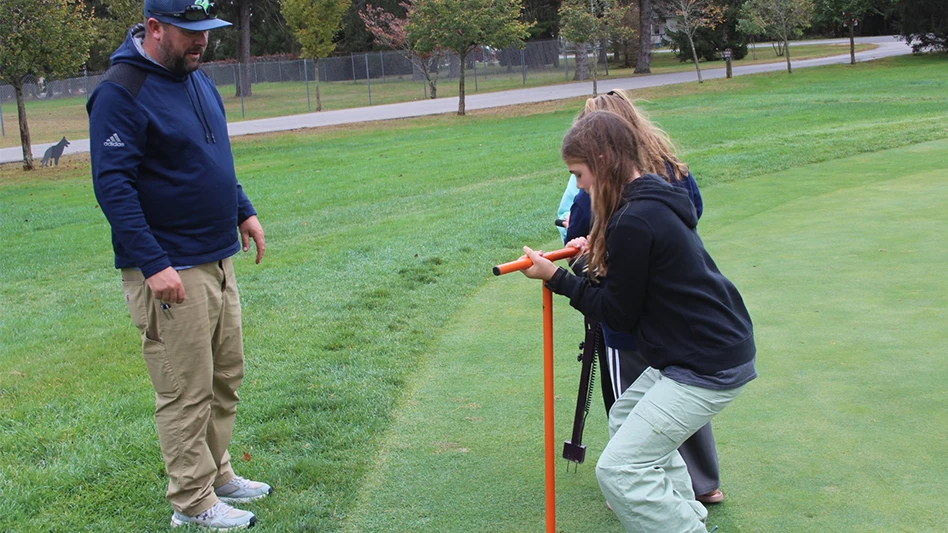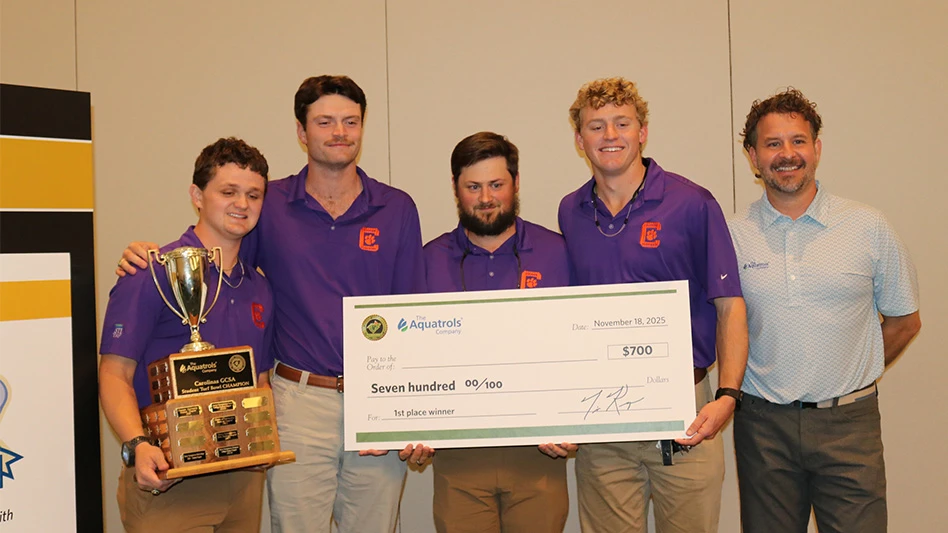

Fair or not, scheduling decisions in Texas often revolve around football season. Tyler Andersen recognized this immediately after becoming the superintendent at the University of Texas Golf Club last May.
He even adjusted his agronomic calendar to align with the Longhorns’ football schedule. Andersen wanted members to experience championship-caliber conditions by Sept. 1, four days before Texas opened its 2015 football season against Notre Dame.
The son of agronomist John Andersen and one of Ken Mangum’s final Atlanta Athletic Club protégé’s, Andersen created a list of objectives to complete within a 120-day stretch to meet the self-created deadline. The list could have stretched the entire length of Darrell K. Royal-Texas Memorial Stadium.
Andersen not only had to learn the quirks of Austin, a vibrant, growing community, he needed the crew to embrace what he calls an “intense” style of agronomics consisting of frequent grooming, topdressing, double mowing and brushing. The weather – as it often does – didn’t cooperate, as Austin received 16 inches of rain in May followed by 100 days of no precipitation.
As rain pelted the Roy Bechtol-designed course which doubles as a private club and the home of UT’s nationally ranked golf teams, Andersen evaluated the condition of the maintenance equipment. The club proved willing to invest in new equipment, and Andersen didn’t take the opportunity to receive a new fleet lightly. His equipment evaluation lasted a month.
Understanding another part of the existing inventory took a bit longer. Andersen inherited what he describes as “hundreds of thousands of dollars” of chemicals he had either no experience or little comfort using. Andersen needed products he could trust to meet the Sept. 1 and other future deadlines, but he also understood the investment made by the club sitting in the room.
So Andersen took a hard took and asked himself what he needed right then to make his job effective, and how could he best utilize the older chemistries and fertilizers to assist his program. “I couldn’t just allow them to sit there because they continue to age as well, and I needed to develop the room to store an inventory of products that I need to continue the success for the future,” he says. “That was a huge, huge challenge.”
For the first time in his career, Andersen made the final call on all agronomic decisions, yet he relied on his past to wade through the chemical conundrum. Andersen’s two biggest agronomic influences are his father John, a regional director of agronomy for Century Golf, and Mangum, the legendary former AAC director of golf course and grounds. Andersen started working at the AAC after graduating from the University of Florida and ascended to become one of Mangum’s most trusted lieutenants. Andersen ended his AAC stint as the superintendent of the Highlands Course, which hosted the 2011 PGA Championship and 2014 U.S. Amateur.
Working for Mangum taught Andersen numerous lessons, including the importance of establishing relationships with manufacturers like Syngenta to solve problems and how to implement chemistries that deliver optimal results. Instead of looking within for a solution to the chemical room dilemma, Andersen sought outside advice, calling his father, regional agronomists, other Austin-area superintendents and representatives from companies he trusted.
Andersen discovered what he learned at AAC – the collective best interests of the industry often supplant any competitive desires. Help came from numerous sources, including Syngenta territory manager Bart Fox. Andersen has worked with Syngenta throughout his career and considers fungicides Briskway, Daconil Action, Heritage Action and Secure, insecticides Acelepryn and Provaunt, the herbicide Monument, and Primo Maxx plant growth regulator among the product he’s comfortable inserting into an agronomic plan.


“I knew what I had experience with,” he says. “I knew what I trusted and I knew who I trusted, and when you are hired to come in and elevate a property to a condition you know it can go to, just instinctively I’m not going to put out a bunch of products that I don’t know about.”
Relaying the reason to upgrade the club’s selection of chemicals provided another unique challenge. Decision makers, after all, notice when a piece of equipment is aging. Fungicides, insecticides, herbicides, fertilizers and wetting agents, while equally important, are invisible to the general membership.
“When I first got here and sat down with my general manager and owners, I went through everything with them on products and fertilizers that I need to turn this place into a daily conditioned championship-type facility,” Andersen says. “I took them to the chemical room and I showed them firsthand the types of materials that were in there, and then I showed them what I needed and why I needed it. It was then almost like the equipment. It kind of sold itself. They hired me knowing that I had a completely different agronomic approach, so they were willing to invest it that.”
Working under the premise improving the greens represented the most important part of hitting his Sept. 1 deadline, Andersen stressed the need to make preventative fungicide and insecticide applications on the greens. Tees and fairways came next on the priority list followed by the primary rough. To protect the club’s previous investments, Andersen constructed a plan where existing products are being used on the 25-acre practice facility for the UT men’s and women’s teams, the driving range, and wayward areas of rough.
“When Tyler showed me the products he inherited, I embraced the challenge of working with him to develop an agronomic program that would use up the assets he had, while integrating products that would deliver the agronomic results he was looking for,” Fox says. “It was an honor that he trusted us to help him. When Tyler looks good, we look good.”
The club borders a nature preserve and environmental tussles aren’t uncommon in Austin – a proposed 36-hole facility involving recognizable golf names has met opposition partly because of water concerns – so Andersen knows he needs to use products supported by research and development. He adds having representatives such as Fox available to answer questions about usage offers further reassurance.

“When I sit down and do my EOP and my agronomic program, I’m calling Bart and asking, ‘Bart, what environmental concerns do I have if any with this? Is it OK to spray or apply along these corridors? What type of movement can I expect?’” Andersen says. “All those BMPs are factored into everything we do because at any moment the Lower Colorado River Authority or the Texas Commission on Environmental Quality can come calling because there’s rare bird in this preserve. It’s one of those things you take into account because you want to be an environmental steward.”
Understanding Austin’s delicate environmental situation represents one of many adjustments Andersen is making. After learning the nuances of zoysiagrass fairways at the AAC, Andersen is maintaining a course with TifSport Bermudagrass fairways, tees and rough, and TifEagle greens. The weather represents a stark contrast to what Andersen experienced in Georgia. Precipitation goes from heavy to non-existent in Austin; Atlanta’s rainfall is typically dispersed throughout the year. Obtaining water can be a struggle in Texas, but the UT Golf Club receives abundant reclaimed water because it rests near a treatment facility.
The club has a strong association with the University of Texas. The majority of the members, many of whom are in their 30s and 40s, are connected to the university. And instead of just satisfying the needs of the membership, Andersen and his crew must cultivate championship practice conditions for collegiate teams with national title aspirations. Jordan Spieth called the club his collegiate home course in 2011-12, and it’s entirely possible another future major champion occupies a spot on the Longhorns’ current roster. The UT practice facility features every turfgrass variety the Longhorns encounter during the course of a season. The combination of a young membership and high-level golf team creates an energetic atmosphere, and forces Andersen to play the part of agronomic educator.
“People are really open to listening to new ideas and new ways of doing things,” he says. “The communication is – and I’m not going to say easier – but maybe a little more direct because members are genuinely interested in what we have going on agronomically, and the changes we’re making now and for the future. For a lot of our members, it’s their first club. There’s a lot more educational input on what we are doing agronomically, why we need to groom and topdress, and our water management practices.”
The membership has noticed the change in playing conditions, as well, which happened to arrive by a certain day last September.
“We achieved our set goal of Sept. 1,” Anderson says. “The place has really started to shine. Membership is ecstatic, ownership is ecstatic, the golf teams, are extremely happy to have a place to practice regularly in similar conditions to what they would see on a day-to-day basis at a tournament venue. But I have only been here 10 months and there’s plenty of room for advancement. As I continue to learn the property … I’m one of those guys that’s pedal to metal. I want to leave something better today than I found it this morning. That’s my mantra to the crew and that resonates with them.”

Explore the March 2016 Issue
Check out more from this issue and find your next story to read.
Latest from Golf Course Industry
- From the publisher’s pen: Conscientious of a bigger role
- Bernhard and Company partners with Laguna Golf Phuket
- Terre Blanche showcases environmental stewardship
- VIDEO: Introducing our December issue
- Bernhard and Company introduces Soil Scout
- Nu-Pipe donates to GCSAA Foundation’s Centennial Campaign
- GCSAA enhances golf course BMP tool
- Melrose leadership programs sending 18 to 2026 GCSAA Conference and Trade Show





